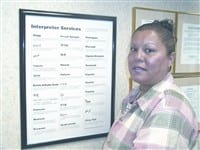A Matter of Time – Stroke Is a Common Killer of Women — but Doesn’t Have to Be
Everyone knows women who are fiercely independent and used to doing everything for themselves. Getting to the hospital after a stroke — or, more likely, getting a friend or loved one there — shouldn’t fall into that category.
“We stress to stroke patients that we want them to come to the hospital quickly,” said Patti Henault, coordinator of Stroke Programs at Mercy Medical Center. “Every minute someone is having a large stroke is a minute that is wasted, and a little part of your brain is going to be damaged. Basically, the quicker you get treatment, the better the outcome usually is. But to arrive as fast as possible, you should call EMS. People think an ambulance takes longer, but the thing is, EMS lets us know they’re coming, so we can get everything in place. That helps a lot.”
Once the patient calls 911, she explained, the ambulance crew is in contact with the hospital, so doctors and CT-scan technicians are in place the moment of arrival. “The first diagnostic test for stroke is do a CT scan, so we know what’s going on inside the brain,” Henault said. “It’s a quick test, but the faster we can do it, the faster we can know whether it’s something we can treat.”
Dr. Rajiv Padmanabhan, a neurologist with Baystate Health, said the system has an algorithm — a chain of command, if you will — for stroke response, and it begins with the EMS team.
“When they call into the hospital, we are on standby, with the CT scan and neurology team and the emergency room; we’re all aware that a patient with a stroke is coming on the ambulance,” he told HCN. “The 911 call triggers the whole thing. They go straight to the CT scan, and we also look at pictures of the arteries.
“The most important lesson is to get them treated fast,” he went on. “Every minute, 1.9 million neurons are lost in the brain. The sooner we treat them, the better chance we have of getting blood supplied back to the brain, which is what we aim for. Once the patient calls 911, the likelihood of a good outcome increases. It sets up a chain of command, which notifies techs, the lab, pharmacy, and the ER. It triggers a chain of events that leads to faster delivery of care. 911 makes a difference.”
According to the American Stroke Assoc., stroke is the third-leading cause of death for women and the fifth-leading cause of death for men; each year, 55,000 more women have a stroke than men. And because women live longer on average than men, strokes often have a more negative impact on their lives. In fact, women are more likely than men to live alone when they have a stroke; require the services of a long-term healthcare facility after a stroke; and have a worse recovery overall.
But with proper management of risk factors, and a quick response when an event occurs, women, as well as men, have a better chance of decreasing mortality rates from stroke and boosting quality of life.
On the Clock
Once a stroke patient arrives at Mercy, Henault said, a consultation is conducted with a neurologist from Massachusetts General Hospital in Boston through that institution’s stroke telemedicine program. “They can see the patient, give directions, answer patient questions, they can even zoom close up on eyes and check the pupils. It’s pretty amazing. They can give us advice on how to treat the patient.”
Mercy began using the Mass General service in Janury 2016 because they are always ready to consult. “The neurologists in our area are often with patients, and it’s difficult to stop what they’re doing. We decided we’d get quicker service with telemedicine. And it really has made an impact.”
About 85{06cf2b9696b159f874511d23dbc893eb1ac83014175ed30550cfff22781411e5} of all strokes are ischemic, caused by a clot, while the rest are hemorrhagic strokes, which are treated differently. In the case of an ischemic stroke, the first line line of defense is the blood-thinning agent tPA (tissue plasminogen activator), known colloquially as a ‘clot buster.’
“If there is a problem like a clot blocking an artery or arteries are very narrowed because of artherosclerosis, we might be able to resume blood flow to the brain,” Henault said. “The idea is, if we can resume blood flow to the brain, the brain cells stop dying because they’re getting the nutrients and oxygen they need.”
For patients that require a more dramatic intervention than a clot buster, a cutting-edge device in use at Baystate known as the ‘stentriever’ can actually be inserted into the artery to remove the clot.
“We’ve incorporated that as part of the protocol,” Padmanabhan said. “We want to make sure we have the right tools, state-of-the-art tools, to respond 24/7/365 and get all patients to the right treatment immediately.”
He added that doctors are waiting on trials and studies examining whether such interventions may be employed more than seven hours after a stroke, which is considered the current limit. (Clot busters like tPA are typically administerd no more than four and a half hours out). “Expanding the window might capture more big strokes before disability and death. We won’t get them all, but we can decrease mortality.”
The best medicine, of course, is not to have a stroke at all, and fortunately, most risk factors are lifestyle-related and can be managed in most people.
“High blood pressure is huge one,” Henault said. “A lot of people think high blood pressure is kind of harmless, but it’s insidious because it does damage to blood vessels every day, and if you have high blood pressure, it’s constantly wearing down the side of the blood vessel, and one crack can develop a blood clot because the body is trying to fix it.”
Other risk factors, she went on, include being overweight, lack of physical activity, and behaviors like smoking, excessive drinking, and drug abuse. “Our younger stroke victims, especially, tend to have some high-risk behavior such as that.”
Some stroke risks require medical intervention, such as atrial fibrillation, or irregular heartbeat, which increases an individual’s chance of developing blood clots. Many with this condition take blood thinners on a regular basis.
“The most important risk factors are hypertension, diabetes, high cholesterol, and obviously smoking,” Padmanabhan said. “Quitting smoking and controlling sugars are important for treating blood pressure. Sleep apnea also has a correlation, so if you feel foggy and tired all the time, check it out and make sure it’s treated. You don’t have to be obese or have a metabolic syndrome to have sleep apnea.”
Although it sounds simple, he added, regular doctor visits can go a long way toward preventing strokes, as will following the American Heart Assoc. guidelines to engage in 20 minutes of moderate exercise five times a week. “The important thing is knowing your numbers. You won’t get to your goals in a day.”
For recovering stroke patients without these risk factors, Padmanabhan said, Baystate’s stroke clinics in Springfield and Greenfield conduct diagnostic cardiac testing to try to determine a cause. But there’s no one way to rehab from a stroke, Henault added.
“No two people are the same. Every section of the brain controls different things, so everyone’s treatment after a stroke is different. Younger brains tend to recover more quickly.”
Different for Women
Each year, according to the American Stroke Assoc., stroke kills twice as many women as breast cancer. But the public tends to be less knowledgeable about the risk factors and don’t perceive themselves at risk for stroke.
In addition to the general risk factors like family history, high blood pressure, high cholesterol, diabetes, smoking, lack of exercise, and being overweight, women face some unique risk factors, including:
• Taking birth control pills. The greatest concern about using oral contraceptives is for women with additional risk factors, such as age, cigarette smoking, high blood pressure, or diabetes;
• Being pregnant. Stroke risk increases during a normal pregnancy due to natural changes in the body such as increased blood pressure and stress on the heart;
• Using hormone-replacement therapy, a combined hormone therapy of progestin and estrogen, to relieve menopausal symptoms; and
• Suffering from migraine headaches with aura. Migraines can increase a woman’s stroke risk two and a half times, and most people in the U.S. who suffer migraines are women.
Women may also report symptoms that are different from common stroke symptoms. These can include loss of consciousness or fainting; general weakness; difficulty or shortness of breath; confusion, unresponsiveness, or disorientation; sudden behavioral change; agitation; hallucinations; nausea or vomiting; pain; seizures; and hiccups. Because these are not typically recognized as stroke symptoms, treatment is often delayed.
Henault said men and women should at least know the FAST symptoms. That’s an acronym stroke-care professionals use to help people recognize the signs of a stroke. The letters stand for facial drooping, arm weakness, speech difficulties, and time — which is of the essence, so call 911 immediately.
“It sounds silly,” she said, “but little kids understand that, and sometimes they end up calling 911.”
It could be the most critical call they ever make, because it launches a chain of events at the hospital designed to save lives — and, more often than ever, does just that.


